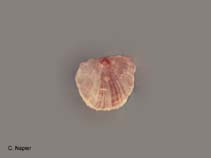Placuna placenta (Linnaeus, 1758)
Windowpane oyster| Native range | All suitable habitat | Point map | Year 2050 |

|
| This map was computer-generated and has not yet been reviewed. |
| Placuna placenta AquaMaps Data sources: GBIF OBIS |
Classification / Names Common names | Synonyms | CoL | ITIS | WoRMS
Bivalvia | Pectinida | Placunidae
Environment: milieu / climate zone / depth range / distribution range Ecology
Benthic; depth range 0 - 100 m (Ref. 348), usually 0 - 20 m (Ref. 75831). Tropical; 25°N - 21°S, 44°E - 149°E
Distribution Countries | FAO areas | Ecosystems | Occurrences | Introductions
Indo-West Pacific: from Gulf of Aden to Taiwan, south to Queensland, Australia.
Length at first maturity / Size / Weight / Age
Maturity: Lm ? range ? - ? cm Max length : 18.0 cm SHL male/unsexed; (Ref. 348); common length : 10.0 cm SHL male/unsexed; (Ref. 348)
Actively collected and often over fished, or commercially cultured for the shells which are used in large quantities for shellcraft. Transparent shells are locally used in some areas as a substitute for window glass in houses. Soft parts are consumed by coastal populations (Ref. 348).
Life cycle and mating behavior Maturity | Reproduction | Spawning | Eggs | Fecundity | Larvae
Members of the class Bivalvia are mostly gonochoric, some are protandric hermaphrodites. Life cycle: Embryos develop into free-swimming trocophore larvae, succeeded by the bivalve veliger, resembling a miniature clam.
Main reference
References | Coordinator | Collaborators
Poutiers, J.M. 1998. (Ref. 348)
IUCN Red List Status (Ref. 130435: Version 2024-1)
CITES status (Ref. 108899)
Not Evaluated
CMS (Ref. 116361)
Not Evaluated
Threat to humans
Harmless
Human uses
Fisheries: commercial
| FishSource |
Tools
More information
Trophic Ecology
Ecology
Life cycle
Distribution
Human Related
Aquaculture profile
Stamps, Coins Misc.
Stamps, Coins Misc.
Outreach
Taxonomy
References
Internet sources
BHL | BOLD Systems | CISTI | DiscoverLife | FAO(Publication : search) | Fishipedia | GenBank (genome, nucleotide) | GloBI | Gomexsi | Google Books | Google Scholar | Google | PubMed | Tree of Life | Wikipedia (Go, Search) | Zoological Record
Estimates based on models
Preferred temperature
(Ref. 115969): 24.2 - 29.1, mean 28.1 (based on 1234 cells).
Resilience
(Ref. 69278):
Medium, minimum population doubling time 1.4 - 4.4 years (K=0.26).
Price category
(Ref. 80766):
Unknown.



